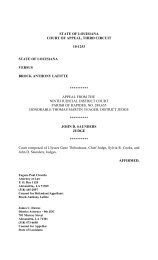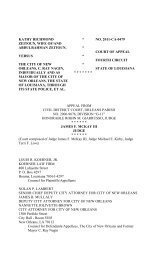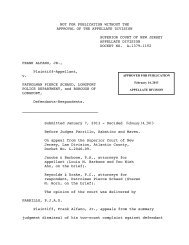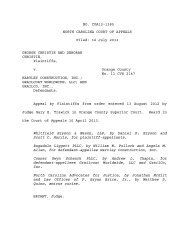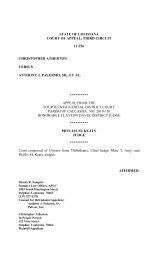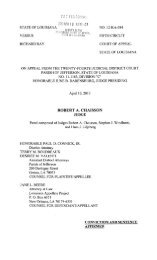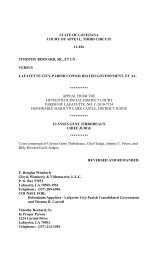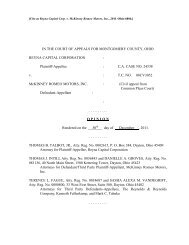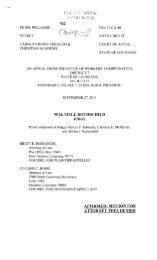RECORD IMPOUNDED - Courthouse News Service
RECORD IMPOUNDED - Courthouse News Service
RECORD IMPOUNDED - Courthouse News Service
Create successful ePaper yourself
Turn your PDF publications into a flip-book with our unique Google optimized e-Paper software.
<strong>RECORD</strong> <strong>IMPOUNDED</strong>NOT FOR PUBLICATION WITHOUT THEAPPROVAL OF THE APPELLATE DIVISIONSUPERIOR COURT OF NEW JERSEYAPPELLATE DIVISIONDOCKET NO. A-5880-11T2NEW JERSEY DIVISION OF YOUTHAND FAMILY SERVICES, 1v.Plaintiff-Respondent,APPROVED FOR PUBLICATIONJune 4, 2013APPELLATE DIVISIONY.N.,Defendant-Appellant,andP.C.,Defendant.________________________________________IN THE MATTER OF P.A.C., a minor.________________________________________Argued April 29, 2013 - DecidedJune 4, 2013Before Judges Graves, Espinosa and Guadagno.On appeal from the Superior Court of NewJersey, Chancery Division, Family Part,Essex County, Docket No. FN-07-297-11.Clara S. Licata, Designated Counsel, arguedthe cause for appellant (Joseph E. Krakora,1 Effective June 29, 2012, the New Jersey Division of Youth andFamily <strong>Service</strong>s was renamed the Division of Child Protection andPermanency. L. 2012, c. 16.
Public Defender, attorney; Ms. Licata, onthe brief).Lisa Rusciano, Deputy Attorney General,argued the cause for respondent (Jeffrey S.Chiesa, Attorney General, attorney; AndreaM. Silkowitz, Assistant Attorney General, ofcounsel; Ms. Rusciano, on the brief).Lisa M. Black, Designated Counsel, arguedthe cause for minor P.A.C. (Joseph E.Krakora, Public Defender, Law Guardian,attorney; Ms. Black, on the brief).The opinion of the court was delivered byGUADAGNO, J.S.C. (temporarily assigned).Y.N. (Yvonne) 2 appeals from the Family Part's July 1, 2011order, following a fact-finding hearing, that determined sheabused or neglected her infant son, P.A.C. (Paul). Paulsuffered severe withdrawal symptoms after birth, caused byYvonne's use of methadone during the last month of herpregnancy. Yvonne argues that she obtained the methadone from a"legitimate program providing assistance from withdrawal," andsuch use cannot serve as a basis for an adjudication of abuse orneglect. She also claims that a finding of abuse or neglect,under these circumstances, is contrary to established case lawthat permits a pregnant woman to be in control of her medical2We employ pseudonyms to protect the privacy of the minor andfor ease of reference.2A-5880-11T2
decisions. For the reasons that follow, we reject thesearguments and affirm.Yvonne began to use drugs in 2005, when she experienceddepression after the death of her infant daughter. Her use ofprescription drugs eventually led to her addiction. When Yvonnecould no longer obtain pills, she began to use heroin andcocaine. She entered a drug treatment facility in 2007, and adifferent program in 2010, but relapsed after discharge on bothoccasions.In September 2010, Yvonne injured her hand. When she wentto a hospital for treatment, she learned that she was pregnant.At the time, Yvonne was living with defendant P.C. (Phil), whoshe identified as the baby's father. When she learned of herpregnancy, Yvonne had been taking opiates for several monthsand, by her own admission, was addicted.On January 5, 2011, four months after learning she waspregnant, Yvonne attended an intake appointment at AmericanHabitare and Counseling, Inc. (AHC) to begin a methadonetreatment program. Yvonne indicated on a form that she had notused heroin, cocaine or oxycodone during the last eight months,but she tested positive for opiates that day. She then admittedto a nurse at AHC that she had been taking "street oxycodone"3A-5880-11T2
every three hours. Before her admission to the program, Yvonnesigned an informed consent form that provided in pertinent part:Besides the possible risks involved with thelong-term use of Methadone, I furtherunderstand that, like heroin and otheropioids, information on its effects onpregnant women and their unborn children isat present inadequate to guarantee that itmay not produce significant or seriouseffects.It has been explained to me that Methadoneis transmitted through the milk to the babyand this may cause physical dependence onMethadone in the child. I understand thatfor a brief period following birth, thechild may show temporary irritability orother ill effects due to my use ofMethadone. It is essential for the child'sphysician to know of my participation in anopioid treatment program so that she/he mayprovide appropriate medical treatment forthe child.Yvonne began with an initial daily dosage of 40 mg ofmethadone on January 5, 2011, but this was increased to 80 mg byFebruary 7, 2011. On February 18, 2011, Yvonne gave birth toPaul at Morristown Memorial Hospital (MMH). Paul testedpositive for methadone and was diagnosed with neonatalabstinence syndrome (NAS), due to his withdrawal symptoms. Fivedays after his birth, Paul was moved from the newborn nursery tothe neonatal intensive care unit (NICU), where he was givendoses of morphine to ease the effects of his withdrawal.4A-5880-11T2
During the early morning hours of February 23, 2011, Philwas at the hospital when he and Yvonne argued about how Phil washolding Paul. When hospital staff intervened, Phil became"verbally hostile" and threatened to remove Paul from thehospital. Hospital security and the Morristown PoliceDepartment were called and Phil was escorted from the hospitaland told not to return. Later that day, Yvonne obtained atemporary restraining order (TRO) against Phil. In addition tothis incident, Yvonne alleged Phil choked her and threw her downstairs in the past. On March 2, 2011, Yvonne requested that thedomestic violence complaint be dismissed and the TRO vacated.On February 24, 2011, a social worker at MMH notified theNew Jersey Division of Youth and Family <strong>Service</strong>s (the Division)about the domestic violence incident between Yvonne and Phil. 3As a result of this referral, the Division began aninvestigation.On March 14, 2011, Phil reported to a Division caseworkerthat Yvonne had relapsed after he found her on her front porchat 2:30 a.m., high on crack cocaine. Yvonne denied these3 It does not appear that anyone from MMH notified the Divisionthat Yvonne gave birth to a child suffering withdrawal symptoms.We take this opportunity to note that N.J.S.A. 9:6-8.10 requires"[a]ny person having reasonable cause to believe that a childhas been subjected to child abuse or acts of child abuse shallreport the same immediately to the Division of Child Protectionand Permanency by telephone or otherwise."5A-5880-11T2
allegations but failed to submit to a urine screen on March 18,2011, at her outpatient clinic.When the Division learned that Paul was due to be releasedfrom MMH on April 1, 2011, they placed a hospital hold on theinfant that temporarily prevented his discharge. The Divisionthen filed a complaint and order to show cause seeking custody,care, and supervision of Paul. The Family Part judge determinedthat the Division had not established that Yvonne presented arisk of harm to Paul, and released Paul to her custody pending anegative drug screening. The Division retained care andsupervision of Paul.On June 29, 2011, a fact-finding hearing was held as toYvonne only. A Division supervisor presented an overview of thecase and introduced the Division's case file, which includedPaul's extensive medical records. A Division caseworker thentestified that she investigated Yvonne's initial allegations ofdomestic violence as well as her failure to submit to a drugscreen on March 18, 2011.Yvonne testified that she was taking Percocet when shelearned she was pregnant and someone told her that she shouldnot stop taking the drug because she "could stand to lose thefetus if [she] stopped due to . . . possible withdrawal."Yvonne recanted all of the allegations of domestic violence she6A-5880-11T2
made against Phil when she obtained the TRO and claimed she waspressured to apply for the TRO by the police and hospital staff.She also admitted that she lied about the prior acts of domesticviolence because she feared she would lose custody of Paul.At the conclusion of the hearing, the court found that theDivision proved by a preponderance of the evidence that Yvonneabused or neglected Paul.On appeal, Yvonne provides the following arguments for ourconsideration:POINT ITHE COURT BELOW DID NOT FOLLOW THEAPPROPRIATE LEGAL STANDARD IN DETERMININGTHAT [YVONNE] ABUSED AND NEGLECTED [PAUL].POINT IITHE DIVISION FAILED TO PROVE THAT [YVONNE'S]PRE-PREGNANCY HISTORY OF DRUG USE OR HERPRE-NATAL INGESTION OF PERCOCET, OXYCONTIN 4OR METHADONE EITHER HARMED [PAUL] OR EXPOSEDHIM TO A RISK OF FUTURE HARM.A. [YVONNE'S] PAST HISTORY OF DRUGDEPENDENCY ON COCAINE AND HEROIN PRIORTO THIS PREGNANCY.B. USE OF PERCOCET AND OXYCONTIN DURINGTHE PREGNANCY UNTIL JANUARY, 2011.4 In her statements to AHC staff and during her testimony at thefact-finding hearing, Yvonne admitted to using oxycodone. Inher brief, defendant refers to the drug as OxyContin. Oxycodoneis a synthetic drug derived from opium. United States v.Ilayayev, 800 F. Supp. 2d 417, 429 (E.D. N.Y. 2011). OxyContinis a controlled-release encapsulation of oxycodone. Id. at 430.7A-5880-11T2
POINT IIIC. RISK OF HARM TO [PAUL] BASED ON THEPOSSIBILITY OF [YVONNE] USING ILLICITDRUGS IN THE FUTURE.THE DIVISION FAILED TO PROVE ANY IMMINENT,SUBSTANTIAL FUTURE RISK OF HARM TO [PAUL]BASED ON THE ALLEGED DOMESTIC VIOLENCEHISTORY BETWEEN [YVONNE] AND [PHIL].The Law Guardian argues that the trial court properlydetermined that Yvonne abused or neglected Paul and, becausethere was proof of actual harm, there was no reason for thetrial court to engage in an analysis of risk of harm.The trial court found that Yvonne learned she was pregnant"at least in September [2010]" and continued to use illicitdrugs until January 2011, when she entered a methadone program.The judge noted that Yvonne admitted that she was aware thatcontinuing to use illicit drugs during her pregnancy was "highrisk," but found that Yvonne "[c]ontinued to take illicit drugs,prescribed and unprescribed, knowing that she was pregnant forthat period of time . . . ." The judge found Yvonne had "a longhistory of drugs, and that she continued to expose the child to[drugs]," and noted, "[w]hen a child is born drug exposed toillicit drugs, we routinely say that's abuse and neglect." Thejudge also found Yvonne's "credibility very questionable . . .[and] had difficulty believing a lot of the things she said."8A-5880-11T2
Our review of the factual findings of a trial judge sittingwithout a jury is limited, and we determine whether thosefindings are supported by adequate, substantial, credibleevidence in the record. Cesare v. Cesare, 154 N.J. 394, 411-12,(1998); Rova Farms Resort, Inc. v. Investors Ins. Co. of Am., 65N.J. 474, 484 (1974).The record contains abundant and compelling evidence of theharm Paul suffered during his period of withdrawal. On February19, 2011, Paul's drug screen was positive for methadone and hewas diagnosed with NAS. While Paul was initially placed in thehospital's well-baby nursery, he had to be transferred to theNICU on February 23, 2011 because of his withdrawal reaction.Paul was given oral doses of morphine every three hours to easehis withdrawal. Then, he had to be gradually weaned from themorphine. Paul's discharge summary indicates that it tookthirty-nine days until the morphine could be discontinued.Yvonne does not dispute that Paul suffered harm during thiswithdrawal period. She contends, however, that a finding ofabuse or neglect cannot be based upon her ingestion of methadonefrom "a legitimate program providing assistance fromwithdrawal." We disagree.The fact that defendant obtained the methadone from a legalsource does not preclude our consideration of the harm it caused9A-5880-11T2
to the newborn. An inquiry under N.J.S.A. 9:6-8.21 must focuson the harm to the child, rather than on the intent of thecaregiver. G.S. v. Dep't of Human Servs., 157 N.J. 161, 180-81(1999). Harm to the child need not be intentional in order tosubstantiate a finding of abuse or neglect. N.J. Div. of Youth& Family Servs. v. M.C. III, 201 N.J. 328, 344 (2010); see alsoG.S., supra, 157 N.J. at 176 ("[U]nder Title 9, whether theguardian intended to harm the child is irrelevant.")"Methadone is a synthetic narcotic and a central nervoussystem depressant." Beazer v. N.Y. City Transit Auth., 399 F.Supp. 1032, 1038 (S.D.N.Y. 1975), modified, 558 F.2d 97 (2d Cir.1977), rev'd on other grounds, 440 U.S. 568, 99 S. Ct. 1355, 59L. Ed. 2d 587 (1979). The District Court in Beazer explainedthe uses of methadone:Methadone has been used, under medicalcontrols, as a pain killer. Also, methadoneis used in "detoxification units" . . . totake addicts off of heroin. This is done byswitching a heroin addict to methadone andgradually reducing the doses of methadone tozero over a period of about three weeks.The patient thus detoxified is drug free.Moreover, it is hoped that the program ofgradually reduced doses of methadone leaveshim without the withdrawal symptoms, or the"physical dependence" on a narcotic.[Ibid.]An argument similar to defendant's was presented in Statev. Tamburro, 68 N.J. 414 (1975), which involved a defendant who10A-5880-11T2
was convicted of operating a motor vehicle while under theinfluence of a narcotic. The defendant admitted to havingingested methadone on the morning of his arrest, but claimedthat the evidence was insufficient, as he was enrolled in amethadone maintenance program and his conviction "adverselyaffects all methadone programs by subjecting participantstherein to charges of violating N.J.S.A. 39:4-50." Id. at 416-17.Our Supreme Court found no merit or validity to thisargument and affirmed the defendant's conviction, concluding,"[d]efendant was found guilty because the evidence showed he wasunder the influence of a narcotic to an extent that itmaterially affected his physical and mental faculties and madeit unsafe for him to operate a motor vehicle on the highway."Id. at 421. The Court held that the fact that the drug inquestion was methadone was immaterial as[t]he statute does not require that theparticular narcotic be identified. It isenough if, from the subject's conduct,physical and mental condition and thesymptoms displayed, a qualified expert candetermine that he or she is "under theinfluence" of a narcotic. This, of course,would include a drug which produces anarcotic effect.[Ibid.]11A-5880-11T2
In New Jersey Department of Children & Families v. A.L.,213 N.J. 1, 22 (2013), the Court statedthe primary question under Title 9 iswhether [the child], as a newborn, "ha[d]been impaired" or was in "imminent danger ofbecoming impaired" as a result of hismother's failure to exercise a minimumdegree of care by unreasonably inflictingharm or allowing a "substantial risk" ofharm to be inflicted. . . . [E]vidence ofactual impairment to the child will satisfythe statute . . . .Paul's severe withdrawal, which required treatment in the NICUand numerous doses of morphine over an extended period of time,is compelling evidence of actual impairment. See also In reGuardianship of K.H.O., 161 N.J. 337, 349 (1999) ("a child bornaddicted to drugs and suffering from the symptoms of drugwithdrawal as a result of her mother's substance abuse duringpregnancy has been harmed by her mother and that harm endangersthe child's health and development"). Where there is evidenceof actual impairment, it is immaterial whether the drugs takenwere from a legal or illicit source.Defendant next argues that she should be in control of hermedical decision to ingest methadone and that a finding of abuseor neglect under these circumstances, "would run counter toestablished case law permitting a pregnant woman to be incontrol of medical decisions, even if such decisions have anadverse effect on the unborn child." We disagree.12A-5880-11T2
Defendant cites New Jersey Division of Youth & Family<strong>Service</strong>s v. S.N.W., 428 N.J. Super. 247 (App. Div. 2012), insupport of her argument. In S.N.W., we vacated a finding that amother had abused or neglected her twenty-month old and fivemonthold children. The finding had been based solely on adetermination that the mother appeared to be under the influenceof Xanax while the children were in her care. We held that themere fact that a parent appeared inebriated is not necessarilydeterminative of whether that parent was providing a minimumdegree of care. We remanded to determine if the defendantingested more than the prescribed dosage of Xanax, and if shedid, whether she was able to exercise a minimum degree of carein that condition.The facts of this case are considerably different. InS.N.W., there was no proof that the mother’s ingestion of Xanaxactually harmed the children. By contrast, Yvonne's use ofmethadone was the direct cause of Paul's severe withdrawalsymptoms, a recognized harm under A.L. and K.H.O.Defendant also relies on the concurring opinion in NewJersey Division of Youth & Family <strong>Service</strong>s v. V.M., 408 N.J.Super. 222 (App. Div.) certif. denied, 201 N.J. 272 (2009),cert. denied, ____ U.S. ____, 130 S. Ct. 3502, 177 L. Ed. 2d1095 (2010). In V.M., the parents of a newborn, appealed the13A-5880-11T2
finding that they abused and neglected their child. After themother was admitted to a hospital for the delivery of her child,she refused to consent to certain invasive treatment, includinga Cesarean section. Id. at 227. Hospital records described themother's behavior as "combative," "uncooperative," "erratic,""noncompliant," "irrational" and "inappropriate." Ibid.Hospital staff determined that the mother had a psychiatrichistory and had been diagnosed with post-traumatic stressdisorder and suffered from either a schizoaffective disorder ora bipolar disorder. Id. at 228-29.The trial judge found that the mother's behavior was"alarming" and "might have caused a reasonable person to believethe child was in danger." Id. at 231. In determining that thechild was abused or neglected, the judge considered the mother'srefusal to consent to a C-section, although he did not base hisfindings solely on that refusal. The concurring opinion, reliedupon here by defendant, held that "[c]onsideration of [amother's] refusal to submit to a C-section . . . is improper andbeyond the legislative scope of the child-protective statutes."Id. at 226. However, the majority in V.M., concluded that,while the trial judge considered the mother's refusal to consentto the C-section, "there was substantial additional evidence ofabuse and neglect that supported the ultimate findings." Id. at14A-5880-11T2
224. Neither the majority nor the concurring opinions in V.M.provide support to defendant's claim that a pregnant woman'sdecision to ingest methadone cannot support a finding of abuseor neglect when the child suffers harm as a result.As defendant admits that her use of methadone caused Paul'swithdrawal symptoms, we need not consider her claim that theDivision failed to prove that her prenatal use of Percocet andOxyContin caused harm to Paul or exposed him to a risk of harm.Affirmed.15A-5880-11T2



